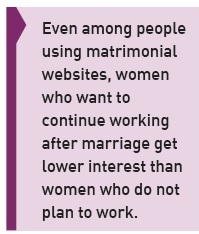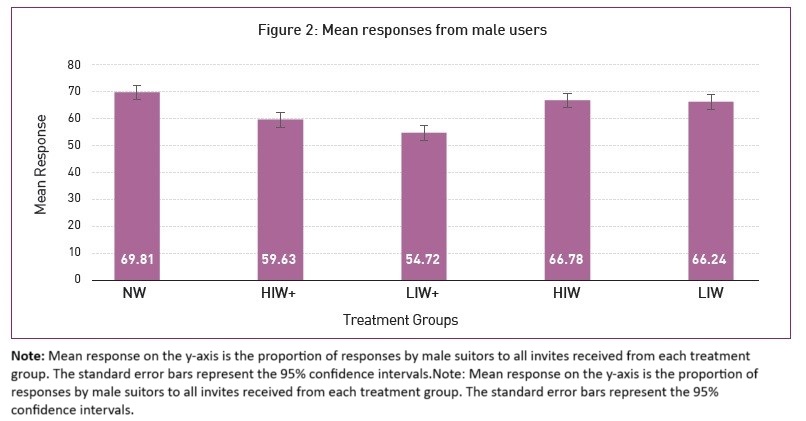 One of the great puzzles of the Indian economy centers on low female labor force participation. India has one of the lowest rates globally, despite increasing female education, improved water, roads and electrification, and dropping fertility rates (Desai et al, 2018). There are likely many interlinked factors, but one issue that has been less delved into is gender norms related to women’s work and marriage. We know from survey data that nearly half of the Indian adults think married women whose husbands earn well should not work outside the home (Coffey et al, 2018), as reflected in popular Indian shows such as Indian Matchmaking.
One of the great puzzles of the Indian economy centers on low female labor force participation. India has one of the lowest rates globally, despite increasing female education, improved water, roads and electrification, and dropping fertility rates (Desai et al, 2018). There are likely many interlinked factors, but one issue that has been less delved into is gender norms related to women’s work and marriage. We know from survey data that nearly half of the Indian adults think married women whose husbands earn well should not work outside the home (Coffey et al, 2018), as reflected in popular Indian shows such as Indian Matchmaking.
How do these attitudes play out in the marriage market? How do working women or higher-earning women fare when they enter the marriage market? To understand women’s experience in the marriage market for women, I conducted the first experimental study on a popular marriage website in India
Using a correspondence experiment design on Shaadi.com, I fabricated marital profiles for women from different castes/sub-castes, modeled on real profiles from users. These profiles did not have photos and were identical on all accounts such as age, height, education, and lifestyle except for their statements about work and income. I also identified a random sample of 2750 active male suitors, meeting certain eligibility criteria including income ($6k-$10k) in/around Delhi. Finally, I randomized these male users to receive expressions of interest from one of the fabricated profiles from the same caste/sub-caste from the following categories:
Control – Never worked (NW): Not working women who do not intend to work after marriage
 Treatment 1 – High income, working women pre-marriage, and post-marriage (HIW+) – Women working at Rs 7-10 lakhs income category, with a stated preference for continuing work after marriage
Treatment 1 – High income, working women pre-marriage, and post-marriage (HIW+) – Women working at Rs 7-10 lakhs income category, with a stated preference for continuing work after marriage
Treatment 2 – Low income, working women pre and post-marriage (LIW+) – Women working at Rs 2-4 lakhs income category, with a stated preference for continuing work after marriage
Treatment 3 – High income, working women pre-marriage only (HIW) – Women working at Rs 7-10 lakhs income category, with a stated preference for giving up work after marriage
Treatment 4 – Low income, working woman pre-marriage only (LIW) – Women working at Rs 2-4 lakhs income category, with a stated preference for giving up work after marriage.
For easier reference, these variations in work and income are captured in the table below:
 After sending the invites from one of these profiles based on the randomization, I monitored the responses from male suitors for a period of 30 days. Male suitors could accept, decline or choose to not respond or request a photo.
After sending the invites from one of these profiles based on the randomization, I monitored the responses from male suitors for a period of 30 days. Male suitors could accept, decline or choose to not respond or request a photo.
Findings
My findings (Dhar, 2023) show that women who have never worked are likely to get the highest number of positive responses from male users (around 70%), as shown in Figure 2. Women who have worked but are willing to give up work after marriage receive around 66% of responses. However, women who want to continue working after marriage are far less likely to receive positive responses. Their acceptance rates are at 59.6% and 54.7% for the high-income (HIW+) and low-income (LIW+) groups respectively. This represents a statistically significant difference in overall response rates of 10 to 15 percentage points from the Never Worked (NW) group, which can be attributed solely to women’s stated desire to work after marriage. This implies that women who have never worked receive 15%-22% more interest in the marriage market compared to women who want to keep working. For every 100 men who respond to a woman who has never worked, only 78-85 men will respond to a woman who wants to keep working.
 I find the same results in the regression analyses across specifications (Figure 3): men are consistently less interested in women who work. However, it’s not the women who earn more relatively who are penalized most. Income acts as a sweetener – women who earn more receive more interest, not less, than their lower-earning peers. As Figure 3 shows, men were 10 percentage points less likely to respond to career-oriented women who earn more than them (HIW+ group). They were 15 percentage points less likely to respond to career women who earned less than them (LIW+ group). The findings show that women who want to work but earn less than their male suitors elicit the least interest.
I find the same results in the regression analyses across specifications (Figure 3): men are consistently less interested in women who work. However, it’s not the women who earn more relatively who are penalized most. Income acts as a sweetener – women who earn more receive more interest, not less, than their lower-earning peers. As Figure 3 shows, men were 10 percentage points less likely to respond to career-oriented women who earn more than them (HIW+ group). They were 15 percentage points less likely to respond to career women who earned less than them (LIW+ group). The findings show that women who want to work but earn less than their male suitors elicit the least interest.
 So what explains this sizeable and significant penalty for career-oriented women?
So what explains this sizeable and significant penalty for career-oriented women?
First, I find these differences are largely driven by the relatively higher castes in the (limited caste) sample such as Brahmins and Agarwals. Next, I explore a few mechanisms by looking across treatment arms in the paper. I find no evidence to support a Human Capital Development channel where there would be a greater preference for women with some work experience before marriage, even if they were choosing to stay at home and not breaking the ‘male breadwinner’ norm. I find a weak effect of the Income channel, where income mitigates some of the penalty career women face, with a stronger preference for higher-earning women. I conclude that the Gender Norms channel is dominant in explaining these results, given the strong differences in preferences for all women who want to work after marriage.
Conclusion
The unfortunate reality is that there is a sizeable penalty in the marriage market for women who express an interest in pursuing a career after work. My research shows that working women, who want to continue working after marriage, are likely to receive significantly lower interest from male suitors. These results are predominant for relatively higher castes in the caste hierarchy, potentially given associations with more conservative gender attitudes around women’s work and purity. Finally, I also conclude that marital preferences are largely driven by conservative gender norms, and the woman’s income has a weak effect at best.
References:
Coffey, Diane, Payal Hathi, Nidhi Khurana, and Amit Thorat. 2018. “Explicit prejudice: Evidence from a new survey.” Economic and Political Weekly 53 (January): 46–54.
Desai, Sonalde, Neerad Deshmukh, and Bijay Chouhan. 2018. Supply or Demand: What Accounts for Declining Female Work Participation Rate in Rural India? [In en].
Dhar, D., (2023). Indian Matchmaking: Are Working Women Penalized in the Marriage Market? 1. Available at SSRN: https://ssrn.com/abstract=4479657
Diva Dhar is the Deputy Director for Women’s Economic Empowerment at the Bill & Melinda Gates Foundation and a Non Resident Fellow at the Future of Development program at the Oxford Martin School.